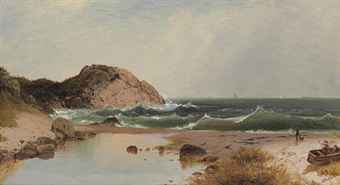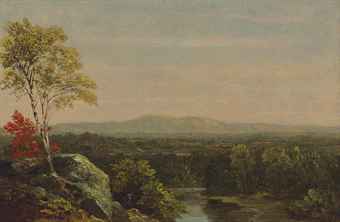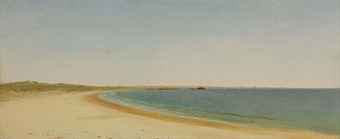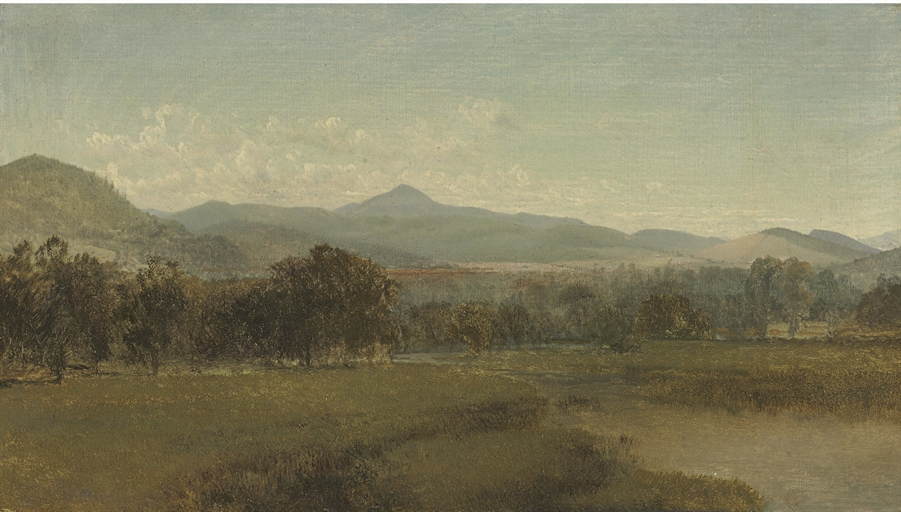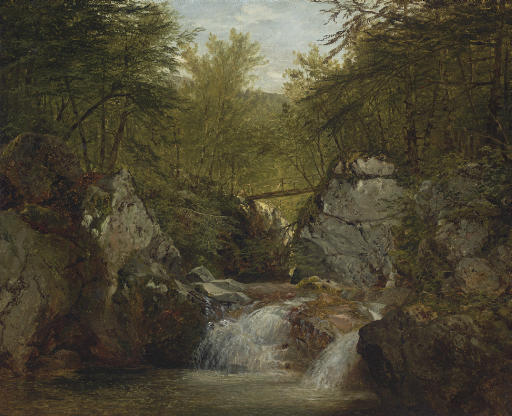Biography
John Frederick Kensett was born on March 22, 1816, in Cheshire, Connecticut, the son of Thomas Kensett, an English engraver who had immigrated to America, and Elizabeth Daggett, a New Englander. By 1828, Kensett had begun studying engraving and drawing in his father's firm in New Haven and in 1829 he worked briefly for the engraver Peter Maverick in New York.Earning his living as an engraver during the 1830s, Kensett also began to experiment with landscape painting, encouraged by his friend John Casilear (1811-1893).
In 1838 he exhibited a work entitled Landscape at the National Academy of Design in New York and by 1840 he had decided to become a full-time painter. In that year he sailed for Europe with fellow artists Casilear, Asher B. Durand (1796-1886), and Thomas P. Rossiter (1818-1871).
After an extended stay in Europe, with visits to London, Paris, Germany, Switzerland, and Italy, Kensett returned to New York in 1847. He rapidly established a name as a landscape painter and was elected an Associate of the National Academy in 1848. In 1849 he was named a full member of the Academy and was also elected to membership in the prestigious Century Club, which brought him into contact with numerous leading artistic and literary figures of the day.
Kensett's early works were generally richly painted and owed much to the inspiration of Thomas Cole (1801-1848) and English landscape painters such as John Constable (1776-1837). Works from the early 1850s combined vigorous and expressive brushwork with carefully observed details of rocks, vegetation, and atmosphere in a strikingly effective way, and were well-received.
By the middle and later 1850s his style had become more precise and meticulous, reflecting the influence of Durand, and he began to favor more tranquil and simplified compositions. Kensett was at the height of his powers in the 1860s and he created some of the most accomplished American landscapes of the nineteenth century.
Although he occasionally painted large works, Kensett generally preferred to work on small to medium sized canvases. Unlike such contemporaries as Frederic Church (1826-1900) or Albert Bierstadt (1830-1902), who travelled to exotic and far-off locales in search of inspiration, Kensett returned again and again to favorite spots that were easily accessible to New York.
Never tiring of the pictorial possibilities of these places, Kensett produced a substantial body of works that seem superficially similar, but in fact have subtle, but significant variations in composition, lighting, and atmosphere. He became so well known for painting certain places, including Bash-Bish Falls, Lake George, and the coastal areas of Newport, Rhode Island, and Beverly, Massachusetts, that many of his contemporaries invariably associated them with his name.
Kensett maintained a high profile in the artistic and cultural circles of New York and was respected and well liked by his fellow artists. In 1859 he was appointed a member of the National Art Commission, which was charged with overseeing the decoration of the Capitol in Washington. He was one of the founders of the Metropolitan Museum of Art in 1870 and also served as a member of its board of trustees. In these same years he began to experiment with simpler and more austere, even reductive, compositions. Many of his works from 1870-1872 were unfinished, but examples such as Eaton's Neck, Long Island (1872, Metropolitan Museum of Art) are remarkable for their powerful arrangements of a few boldly simplified shapes representing earth, sea, and sky.
On December 14, 1872, Kensett died in New York City, of pneumonia and heart disease contracted while trying to retrieve the body of a friend's wife from the waters off Contentment Island, Connecticut. His passing at the age of fifty-six was considered virtually a national tragedy, and when the contents of his studio were auctioned in 1873 they brought more than $136,000, an astonishing sum for the period. For many of his contemporaries Kensett had represented a kind of artistic epitome in landscape painting.
Sotheby's 2014
LOT SOLD. 81,250 USD
Sotheby's 2011
LOT SOLD. 22,500 USD
Sotheby's 2010
LOT SOLD. 98,500 USD
Christie's 2013
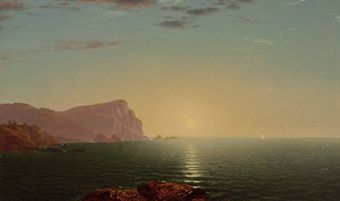
National Gallery (Washington DC)
- Kensett, John Frederick
- , American, 1816 - 1872
- Landing at Sabbath Day Point
- c. 1853
- oil on canvas
- overall: 25.4 x 39.9 cm (10 x 15 11/16 in.)
- framed: 38.1 x 52.1 x 6.4 cm (15 x 20 1/2 x 2 1/2 in.)
- Gift of Mrs. Sigourney Thayer
- Kensett, John Frederick
- , American, 1816 - 1872
- Beacon Rock, Newport Harbor
- 1857
- oil on canvas
- overall: 57.2 x 91.4 cm (22 1/2 x 36 in.)
- framed: 85.7 x 119.4 x 10.2 cm (33 3/4 x 47 x 4 in.)
- Gift of Frederick Sturges, Jr.
- Kensett, John Frederick
- , American, 1816 - 1872
- Beach at Beverly
- c. 1869/1872
- oil on canvas
- overall: 55.8 x 86.4 cm (21 15/16 x 34 in.)
- framed: 85.1 x 115.6 x 8.6 cm (33 1/2 x 45 1/2 x 3 3/8 in.)
- Gift of Frederick Sturges, Jr.



